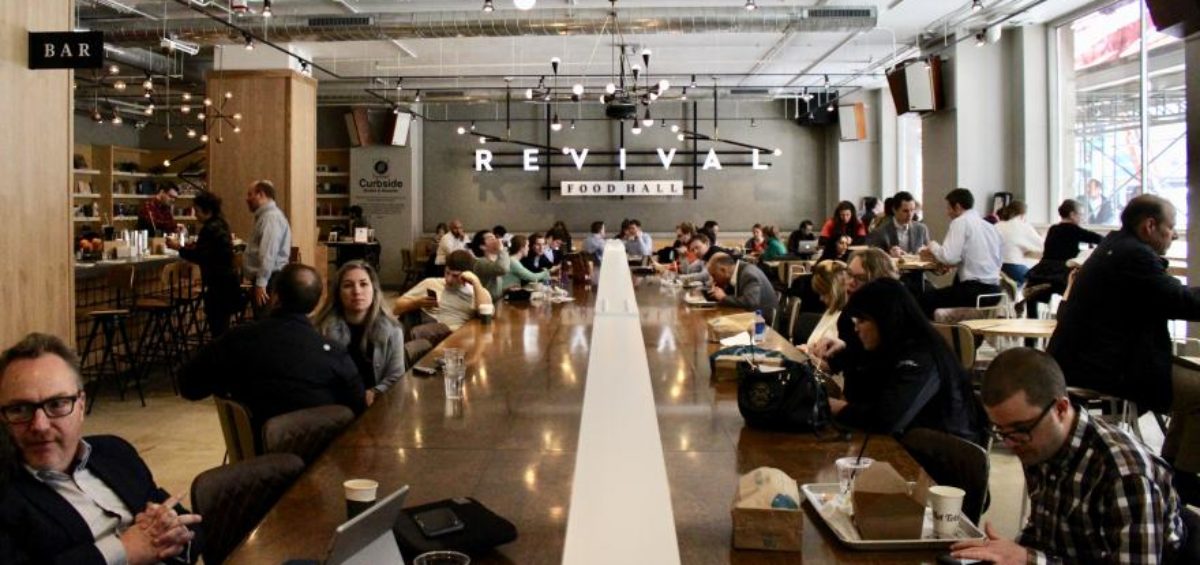How food halls are equipped to weather COVID-19
In 2019 and early 2020, food halls were a booming trend of the food and beverage industry. These spaces are the home of several vendors, often consisting of independent, artisanal foodservice operators and boutique food retailers. As brick-and-mortar shopping has steadily been disrupted by e-commerce, more retail spaces have been filled with food halls. The food hall model is differentiated from typical mall food courts by its unique vendors as well as a focus on experiential concepts.
The popularity of these spaces was spurred by consumer desire for these social experiences, as well as for authenticity and for fewer chain restaurants, according to Garrick Brown, vice president of retail research for the Americas at commercial real estate services firm Cushman & Wakefield.
Cushman & Wakefield’s “The Food Hall Model: Independent F&B’s Pathway to Post-COVID-19 Profitability” report outlines how the sector is positioned to survive the coronavirus pandemic. The low operating costs, adaptable public spaces and landlord relationships allow the unique restaurant concept to adjust practices and transform physical areas to accommodate the new normal of the pandemic for essential businesses.
Shopping center Rosedale Center in Roseville, Minn., is the site of one of these food halls: Potluck. The space houses several food merchants with the intention of offering quality regional food. Sarah Fossen, director of Marketing + Experience for Rosedale Center, attributes the attraction of Potluck, and food halls in general, to customer desire for social interaction while enjoying a variety of dining options.
“We’re often in a hurry, and if you’re dining with others you may not want the same thing, but we want diversity in offerings and quality food made by local chefs,” she said.
Chicago’s Revival Food Hall emerged as a way to offer more foodservice and hospitality choices to an underserved food market — The Loop neighborhood — and as a way to build a form of community, said Bruce Finkelman, Managing Partner at Revival
“People often forget the main rule of hospitality; You have to provide a space that people want to be a part of and want to be in,” added Finkelman.
Phil Colicchio, Cushman & Wakefield’s executive managing director of specialty F&B, entertainment and hospitality, reported that while food halls are attractive across generations, the trend was especially favored by millennials and members of Generation Z pre-pandemic. These are the groups that are also likely to continue their support during the pandemic as well as after restrictions are lifted, he added.
Preparedness for a pandemic
Following many state’s lockdown orders for public health, reopening plans have been complex for the foodservice industry, especially for independent operators.
“Everyone is looking for creative ways to raise revenue in an already precarious time as well as figure out ways to do this safely,” said Finkelman.
However, food halls have been surprisingly well-equipped to embrace the safety protocols that are now necessary during the pandemic, such as social distancing guidelines and increased use of pickup and delivery services.
“[Food halls] are a social-driven concept; you wouldn’t think that in the time of social isolation that that could end up being a plus,” said Brown. “The space that food halls contain, geared for social interaction normally, those spaces easily pivoted to social distancing space [when the pandemic hit].”
Colicchio also noted that roughly 80% of food halls that opened pre-pandemic have stayed open during the coronavirus crisis. The food halls that have suffered tended to be businesses that depend on traffic from office populations.
“We are able to evaluate what is working, what are we missing, and make changes,” said Fossen about how Potluck has been able to maintain its operations and effectively serve its customers, even during this complicated time for the food and beverage industry. Potluck also utilized social media and prioritized unique monthly programming to continue direct connection with consumers.
“They’ve been able to adapt, that’s the critical thing for the success of food halls throughout the pandemic,” said Brown.
The future of food halls
“The crisis that we are facing today was not created by a lack of interest or a lack of spending on artisanal food products,” said Colicchio.
He posited that people will continue to support independent food operators as the economy improves, especially when adults begin to return to working in offices. Food halls are here to stay, and he advises these businesses to keep the reopening lessons that the industry has learned during the pandemic in mind. While third-party delivery services may not continue to grow as rapidly post-pandemic, the model is certainly not going away. Colicchio emphasized that food halls must continue to accommodate delivery and pickup options in their design to be as successful as possible.
Brown reflected on the future of food halls, noting that the restaurant concept had already begun to evolve before the pandemic. Previously viewed as a primarily urban, high-density destination, many food halls began branching out to places such as the suburbs, campuses and roadsides. Brown also said that he believes many new food hall businesses will likely emerge post-pandemic because the model is “a natural place and mechanism for the restaurant industry to rebuild.”



